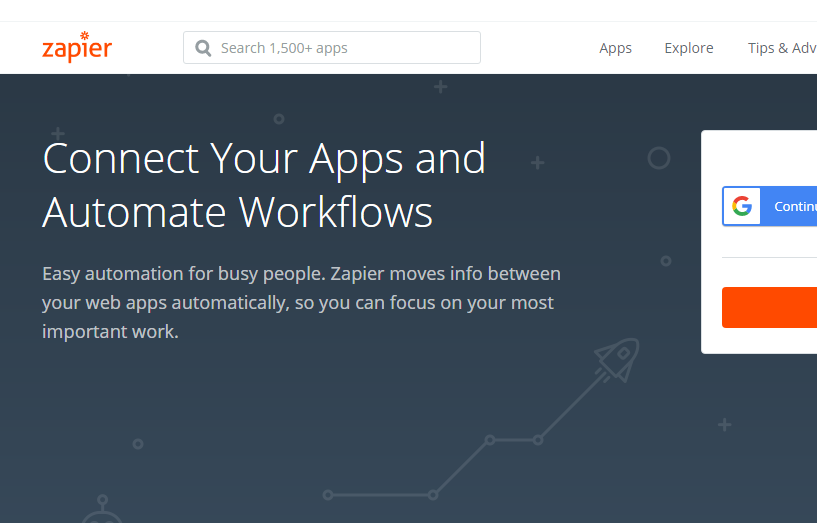You’re proud and you should be.
You’ve built something remarkable. Your product truly helps people and makes their lives a little bit better.
But if your copy is boring, it’s going to be a hard sell.
Now, you might be bringing a new tool or solution to the market. One that’s super useful, different and needed.
To get your goods to your ideal customers, you have to show them what’s in it for them. This demands a new approach to your content creation.
So, to get us started, let’s time travel back to the early 90’s in a city right at the tip of Africa.
Growing up, I didn’t have access to the internet. I had a very vague understanding that some computers let you talk to people…somehow. (I guess that was email.)
As I started working, my career would become intertwined with the web.
When I set foot in the newsroom, only one computer had Facebook access. You’d head over to the news desk if you needed to check something for a story. By the time I left, stories that first broke on social media were routinely making national headlines.
Now, as a writer working remotely with companies across the world, the internet connects me to a career I love: new opportunities, skills, and professional relationships I value deeply. It’s all been made possible by…a set of computers and cables.
That’s all the internet really is, right?
So, imagine you’re the co-founder of this new product, called the Internet.
(A 2019 Tim Berners-Lee who’s on podcasts, TechCrunch and really funny on Twitter.)
You start by writing down what your technology actually does:
“The internet is a globally connected network system that uses TCP/IP to transmit data via various types of media.”
That’s Technopedia’s definition of the internet.
That’s a fact.
It’s also a feature.
But, would you be eager to sign up for a “globally connected network system that uses TCP/IP to transmit data via various types of media”?
Sounds fancy and all, but so what?
Now let’s answer that “so what” and see how it changes the value proposition:
A network that connects you to people, jobs, skills and causes across the world. No matter where you are.
You’re demonstrating the opportunities for progress, the potential for getting better.
You’re edging closer to something people may pay attention to…maybe even care about.
And that’s because you’re tapping into your customers deeper desires.
Marketing research collated by HubSpot shows more and more B2B companies know content will key to attracting and delighting customers.
Content that clearly makes a compelling case for the value of your product should sit at the centre of your content plan. You have more fun creating it, and your customer knows exactly how your service will make their life better.
I’ve embarked on a quest to find the best methods to achieve this goal, backed by research and used by the world’s best copywriters.
“Figure Out to Make Them Care”
Jonah Beger, in Contagious, calls this drilling down to the “emotional core of the idea”.
Berger, a marketing professor, examines how ideas spread and what makes some concepts stick. Berger’s been studying social influence for 15 years and applies these insights to products.
And his analysis is fascinating – shifting from the viral success of Blendtech’s legendary “Will it Blend” videos, to the enduring allure of a secret bar nestled behind a phone booth in New York Cty’s East Village.
In his commentary, Berger introduces us to the Three Whys method from Make it Stick, by Chip and Dan Heath.
(If you have – or are planning to get Contagious – it’s on page 118.)
“Write down why you think people are doing something. Then ask “Why is this important?” three times.”
And here’s this approach in action, using online search.
Why is search important?
Because people want to find information quickly.
Why do they want to do that?
So they can get answers to what they are looking for.
Why do they want those answers?
So, they can connect to people, achieve their goals, and fulfil their dreams.”
You can see Google has honed and perfected this technique.
Here’s a video:
The clip doesn’t carry monologues on crawling or indexing or algorithms. It’s incredibly moving, taking full advantage of the irresistible pull of storytelling.
Bergers ends with a simple piece of advice: figure out how to make them care. Once you get that right, your “so what” becomes your superpower and a powerful business tool.
Stop Killing your Copy with Fake Benefits
We’ve all done it.
When communicating our business value, we muddy real benefits with fake benefits.
In this article, Brian Clark discusses direct response copywriter Clayton Makepeace’s warning against these sham benefits.
To get the point across, they use this headline:
Balance Blood Sugar Levels Naturally
So, that sounds good. I wouldn’t mind balancing my blood sugar levels. Getting the job done naturally? Even better.
The only problem is, as Clark points out, no one is awake at 3 am worrying about the best way to balance their blood sugar levels.
But, they may care about all the bad things that come along with an illness like diabetes.
Makepeace articulates the real benefit in that headline:
“Nobody really wants to balance their blood sugar levels. But anyone in his or her right mind DOES want to avoid the misery of blindness … cold, numb, painful limbs … amputation … and premature death that go along with diabetes.”
In the post, Clark provides a step-by-step process for extracting the true benefits of your product.
You can read up on the whole system in the article, but here’s a summary:
- List all your products features
- Ask yourself why you’ve included each of these features
- Build on that why and connect it to your customers wants and needs
Clark recommends if you’re selling to a B2B tech audience, you may be able to get away with listing features – and not going over the top with emotions.
However…you still need to make the benefit clear for your customer, the “what’s in it for me?”.
“For business buyers, you’re stressing “bottom line” benefits from innovative features.
“If you can demonstrate that the prospect will be a hero because your CRM product will save her company $120,000 a year compared to the current choice, you’ve got an excellent shot.”
Let’s see a real-life example of how you might implement this tactic.
Have a look at Zapier’s site. Unpack the second line in the crosshead:

Zapier moves info between your web apps automatically (Feature)
…so, you can focus on your most important work (Benefit)
And in the era of constant distractions, – where attention has become a commodity – focus is emerging as a new competitive advantage. Now, that’s a compelling promise.
Simulate Real Life
A good way to make benefits real? Be specific.
You want your customers to quickly sum up exactly how your tool is going to make their lives better. To do that, they need to see it in action – in their mind’s eye. You need them to picture how much easier, faster, better X task is going to be once they’re using your product.
The always-awesome Joana Wiebe, from Copyhackers, explains it beautifully in this copywriting tutorial:
“We want to get way more specific and we want to start getting into a world where we can simulate a form of reality with our words, which is what writing has always been about.”
(This tutorial is about 20 minutes long and packed with truly practical advice on getting concrete benefits. The example is a tech product, so very relevant if you’re selling a technical service.)
A good way to help a customer see the “what’s in it for me” is to show the value of the project in real life.
Wiebe calls on us to bring “our copy to life”.
Here’s how Wiebe does that, using the example of a handheld printer:
“Hold this tiny printer in the palm of your hands…It’s lighter than a baseball…You could fit 59 of them inside your old inkjet printer.”
That’s a vivid picture, right? You could just have said:
“This printer is small and compact.”
For some real copy inspo, let’s head over to one of the best in the business, Apple.
Here’s they describe the new iPhoneX.
On the display:
Introducing Liquid Retina. The new display on iPhone XR is the most advanced LCD in the industry. An innovative backlight design allows the screen to stretch into the corners. So you see true-to-life colour from one beautiful edge to the other.
Can you imagine this?
So, I’d encourage you right now to begin by listing the features of your product, and asking why that’s included, and connecting that why to your prospect’s true desires.
When you write this way, two things happen:
- You create a more rewarding and simpler experience for your customers
- You enjoy the writing more – there’s something special about putting those concrete benefits down; a feeling that it’s bound to connect with your ideal customer
Once you have your bona fide benefits, you can use them to guide your content creation. Include these in your blog posts, social media updates, and video content. You’re tapping into your customer’s struggles, and promising a solution – a transformation.
You know that’s the deal. The real magic happens when your customers know it, too.
For more on how to step inside your customer’s mind, read my post for practical tips to get accurate customer data.
